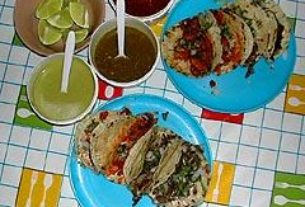Enticing colors, graceful shapes and heady fragrances are all part of the appeal of summer fruit. While a wide array of fresh fruit is available in Mexico year round, it is during the summer that the national mango frenzy reaches its peak, along with a propensity toward the consumption of endless montones (the neat piles of fruit and vegetables that crowd the markets) of plums, peaches and melons.
In recent years, summer has brought an abundance of what used to be considered “exotic” fruit to foreign markets as well. Mangos from South America, the Carribbean and western Mexico find their way to northern supermarkets, as do pineapples, stone fruits, berries, and a variety of melons.
However, the lure of these delights, tropical and otherwise, often leads the shopper to blissfully fill the shopping cart with bags of fruit which, all too often, seem to lose their appeal when confronted with problems of storage, bruising and overripening. What was once pictured as a lovely, aromatic fruit bowl arrangement often ends up as a less-than-attractive, soggy mess, but one that can be prevented. Using fruit in creative south-of-the border recipes, along with following a few rules of thumb long practiced in Mexico’s warmer climes, shoppers can get the most out of summer’s bounty of fresh fruit.
The warm coastal areas of Mexico have long been known for their use of tropical fruit as an accompaniment, and garnish, for grilled seafood. From humble Campeche restaurants serving camarones al coco (coconut shrimp) to upscale Acapulco restaurants featuring grilled fish and chicken dishes with mango and avocado butters, incorporating fruit as either an integral flavor or an accompaniment to the main dish has long been a local culinary practice.
This first of a two-part feature on using fruit in cooking and garnishing focuses on salsas. Fruit salsas, which combine Mexican flavors and techniques with a Southwest influence, are perfect for the warm weather which finds many readers gearing up for grilling, chip-and-dipping, and outdoor entertaining. While it is rainy season here in Mexico, much of the Northern Hemisphere is enjoying the treasured warmth of summer, and this means picnics, barbeques and trips to the beach. The versatile fruit salsas can be used in a number of ways on these occasions.
Served as an accompaniment to grilled chicken dishes, fruit salsas provide just the right amount of flavor – a combination of cool, refreshing fruit and the zing of chiles, complimented by the addition of chopped fresh herbs, such as mint and cilantro. The salsas, in this case, offset the need for gooey barbeque sauces. With fish, the accompanying salsas add zest to what may otherwise be perceived as a “bland” dish, and avocado-and-fruit combinations are particularly good. With grilled pork tenderloins, nothing tastes better than a sweet-and-spicy pineapple salsa.
These salsas are also perfect for serving with chips or even with tostadas. They are more kid-friendly than some of the tomato or tomatillo-based salsas might be, and kids will have fun creating their own combinations. Mango and pineapple salsas can easily be combined with black beans to make a more substantial “dip”, one which is currently enjoying immense popularity.
While there probably won’t be many leftovers, it is important to remember that fruit, once cut, will only be good for a few hours outside the refrigerator in an open container. After that, it should be covered and placed in a cooler or refrigerator and a few drops of lime added, if that has not already been done, to prevent discoloration.
Although its best to do as the Mexicans do, and only buy the produce needed for a couple of days at a time, many shoppers are too busy to do this. If you need to shop for several days at once, remember that supermarkets north-of-the-border, just like Mexican market stalls, stack their produce so that the ripest is on the top. Do not hesitate to choose from underneath if you are buying a few days ahead of time.
When you get home from the market, put the fruit into containers that allow it to “breathe”, such as colanders, strainers and baskets. Here in Mexico, fruit is stored in the sturdy, all-purpose chichihuite, a basket woven of palm or tule which is used for everything from storing dried chiles to serving tortillas. Bananas, along with apples and stone fruit, emit ethylene gas as they ripen, and should not be stored where air cannot circulate. Unripe avocados can be placed in a paper bag with an apple or a banana to speed up the ripening process.
And lastly, remember that bananas and other tropical fruit cannot adapt to cold temperatures, so only after cutting should they be refrigerated. Remember “Chiquita Banana”? Her song was part of the childhood of millions of baby boomers, but I wonder how many of us remember the words. If you do, then you already know that
“Bananas like the climate
Of the tropical equator
So never put bananas
In the refrigerator.”
- Avocado and kiwi salsa: Salsa de aguacate con kiwi
- Mexican mango salsa: Salsa de mango
- Mexican pineapple salsa: Salsa de piña
- Mexican cantaloupe salsa: Salsa de melón


